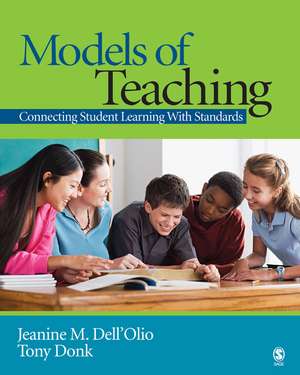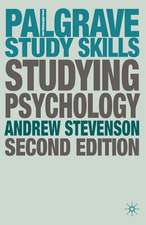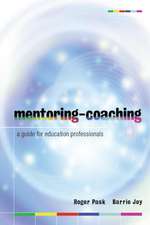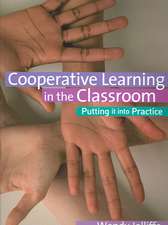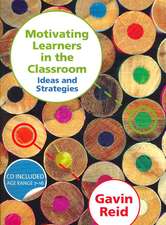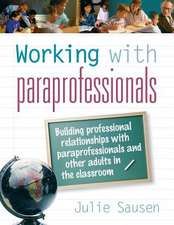Models of Teaching: Connecting Student Learning With Standards
Autor Jeanine M. Dell'Olio, Tony Donken Limba Engleză Paperback – 24 apr 2007
Preț: 995.56 lei
Preț vechi: 1363.78 lei
-27% Nou
Puncte Express: 1493
Preț estimativ în valută:
190.50€ • 199.30$ • 158.25£
190.50€ • 199.30$ • 158.25£
Carte tipărită la comandă
Livrare economică 03-17 aprilie
Preluare comenzi: 021 569.72.76
Specificații
ISBN-13: 9781412918107
ISBN-10: 1412918103
Pagini: 504
Dimensiuni: 203 x 254 x 24 mm
Greutate: 0.89 kg
Ediția:1
Editura: SAGE Publications
Colecția Sage Publications, Inc
Locul publicării:Thousand Oaks, United States
ISBN-10: 1412918103
Pagini: 504
Dimensiuni: 203 x 254 x 24 mm
Greutate: 0.89 kg
Ediția:1
Editura: SAGE Publications
Colecția Sage Publications, Inc
Locul publicării:Thousand Oaks, United States
Recenzii
“The models approach provides a way of connecting theory and practice in ways that other approaches do not. Some of the texts that I have used discuss theory separately from application, and it's always a challenge for students to grasp the connection and figure out how they could use the knowledge in practice. I have seen the models approach used with a graduate level course in instructional technology that I used years back. It's good to see that applied to an undergrad course. I have ongoing concerns about starting with technology. I would much rather focus on the teaching and then figure out the technology. Using a models approach has the potential to give students a stronger conceptual base into which they can think about technology.”
"It is a good textbook for teacher-educators as well as for teachers who are facing evolutionary changes in the pedagogy of classroom instruction and how this classroom instruction could be supplemented by ICT—web-based student study site...This publication is a good case for useful contemporary reference."
"It is a good textbook for teacher-educators as well as for teachers who are facing evolutionary changes in the pedagogy of classroom instruction and how this classroom instruction could be supplemented by ICT—web-based student study site...This publication is a good case for useful contemporary reference."
Cuprins
PREFACE
PART I. WHAT WE TEACH AND WHY
1. Working with Standards and Benchmarks
Introduction
Addressing the question, “What will I teach?”
The standards-based reform movement
State and Local Standards
National Professional Organizations
Conclusion
2. Philosophies of Curriculum and Instruction
Introduction
Academic Rationalism
Cognitive Processing
Curriculum as Technology
Self-Actualization
Social Reconstructionism
Conclusion
3. The Role of Assessment
Introduction
Summative Assessments
Formative Assessment
Assessment and Issues of Quality
Facilitating Student Self-Assessment
Conclusion
PART II. THE MODELS OF TEACHING
4. Direct Instruction
Introduction
Case Study 4.1: 3rd Grade Abbreviations in Addresses
Case Study 4.1: Post-Lesson Reflection
The Stages of Direct Instruction
Case Study 4.2: Middle School – Improper Fractions and Mixed Numbers
Case Study 4.2: Post-Lesson Reflection
A Brief History and Background of Direct Instruction
Technology and Direct Instruction
Direct Instruction, Content Standards, and Benchmarks
Why Choose Direct Instruction?
Conclusion
Putting it Together
5. Concept Attainment
Introduction
Case Study 5.1: Second Grade Science
Post-Lesson Reflection
Stages of Concept Attainment
Case Study 5.2: Fifth Grade Math
Case Study 5.2 Post-Lesson Reflection
A Brief History and Background of Concept Attainment
Concept Attainment and Technology
Concept Attainment, Content Standards, and Benchmarks
Why Choose Concept Attainment?
Conclusion
Putting It Together
6. The Inductive Model
Introduction
Case Study 6.1: First and Second Grade Multiage Social Studies
Case Study 6.1: Post-Lesson Reflection
The Stages of the Inductive Model
Case Study 6.2: Fifth Grade Social Studies
Case Study 6.2: Post-Lesson Reflection
A Brief History and Background of the Inductive Model
Technology and the Inductive Model
The Inductive Model, Content Standards, and Benchmarks
Why Choose the Inductive Model?
Conclusion
Putting It Together
7. Reciprocal Teaching (RT)
Introduction
Case Study 7.1: Fifth Grade Reading
Case Study 7.1 Post-Lesson Reflection
The Stages of Reciprocal Teaching
Case Study 7.2: High School Government
Case Study 7.2: Post-Lesson Reflection
A Brief History and Background of Reciprocal Teaching
Technology and Reciprocal Teaching
Reciprocal Teaching, Content Standards and Benchmarks
Why Choose Reciprocal Teaching?
Conclusion
Putting it Together
8. Question-Answer Relationship (QAR)
Introduction
Case Study 8.1: Third Grade Language Arts
Case Study 8.1 Post-Lesson Reflection
The Stages of QAR
Case Study 8.2: Middle School Science
Case Study 8.2: Post-Lesson Reflection
A Brief History and Background of QAR
Technology and QAR
QAR, Content Standards and Benchmarks
Why Chose QAR?
Summary
Putting it Together
9. Jigsaw
Introduction
Case Study 9.1 High School Social Studies
Case Study 9.1 Post-Lesson Reflection
Stages of the Jigsaw Model
Case Study 9.2 Sixth Grade On-Line Research – A Jigsaw Modification
Case Study 9.2 Post Lesson Reflection
Additional Cooperative Learning Structures
A Brief History and Background of Jigsaw
Technology and Jigsaw
Jigsaw, Content Standards, and Benchmarks
Why Choose Jigsaw?
Summary
Putting It Together
10. Role Playing
Introduction
Case Study 10.1 Middle School Anger on the Playing Fields
Case Study 10.1 Post-Lesson Reflection
Themes in Role Playing for Social Studies and Literature
Case Study 10.2 Fourth Grade The Tattle Tale Problem
Case Study 10.2 Post Lesson Reflection
A Brief History and Background of Role Playing
Technology and Role Playing
Role Playing, Content Standards, and Benchmarks
Why Choose Role Playing?
Summary
Putting It Together
11. Inquiry-Based Learning
Introduction
Case Study 11.1: Middle School Science
Case Study 11.1: Post-Lesson Reflection
Structuring Inquiry-Based Learning Experiences
Case Study 11.2: Third Grade – Inquiry-Based Units
Case Study 11.2: Post-Lesson Reflection
A Brief History and Background of Inquiry-Based Learning
Technology and Inquiry-Based Learning
Inquiry-Based Learning, Content Standards, and Benchmarks
Why Choose Inquiry-Based Learning?
Summary
Putting It Together
12. Synectics
Introduction
Case Study 12.1: Middle School Writing
Case Study 12.1 Post-Lesson Reflection
The Stages/Structure of Synectics
Case Study 12.2: High School Science
Case Study 12.2: Post-Lesson Reflection
A Brief History and Background of Synectics
Technology and Synectics
Synectics, Content Standards and Benchmarks
Why Chose Synectics?
Summary
Putting it Together
13. Advance Organizers
Introduction
Case Study 13.1: High School Science
Case Study 13.1 Post-Lesson Reflection
The Stages of Advance Organizers
Case Study 13.2: Fifth Grade Social Studies
Case Study 13.2: Post-Lesson Reflection
A Brief History and Background of Advance Organizers
Technology and Advance Organizers
Advance Organizers, Content Standards and Benchmarks
Why Chose Advance Organizers?
Summary
Putting it Together
PART III. DEVELOPING CURRICULUM THAT ADDRESSES CONTENT STANDARDS
14. Developing Original Instructional Units Based on Standards, Benchmarks, and Grade Level Expectations
Introduction
What Is Curriculum? What Is Instruction?
State and District Content
Emphasizing the Relevance of the Curriculum
Diversity in Your Classroom
Sequencing Instructional Units
Unit Organization
Choosing Models of Teaching
Modifying Instruction for Students with Special Needs
Personnel
Resources
Assessment and Evaluation of Student Learning
Assessing and Evaluating Teacher Effectiveness
Student-Centered Rationales for Curricular and Instructional Decisions
Modifying Curriculum
Summary
APPENDIX
GLOSSARY
PART I. WHAT WE TEACH AND WHY
1. Working with Standards and Benchmarks
Introduction
Addressing the question, “What will I teach?”
The standards-based reform movement
State and Local Standards
National Professional Organizations
Conclusion
2. Philosophies of Curriculum and Instruction
Introduction
Academic Rationalism
Cognitive Processing
Curriculum as Technology
Self-Actualization
Social Reconstructionism
Conclusion
3. The Role of Assessment
Introduction
Summative Assessments
Formative Assessment
Assessment and Issues of Quality
Facilitating Student Self-Assessment
Conclusion
PART II. THE MODELS OF TEACHING
4. Direct Instruction
Introduction
Case Study 4.1: 3rd Grade Abbreviations in Addresses
Case Study 4.1: Post-Lesson Reflection
The Stages of Direct Instruction
Case Study 4.2: Middle School – Improper Fractions and Mixed Numbers
Case Study 4.2: Post-Lesson Reflection
A Brief History and Background of Direct Instruction
Technology and Direct Instruction
Direct Instruction, Content Standards, and Benchmarks
Why Choose Direct Instruction?
Conclusion
Putting it Together
5. Concept Attainment
Introduction
Case Study 5.1: Second Grade Science
Post-Lesson Reflection
Stages of Concept Attainment
Case Study 5.2: Fifth Grade Math
Case Study 5.2 Post-Lesson Reflection
A Brief History and Background of Concept Attainment
Concept Attainment and Technology
Concept Attainment, Content Standards, and Benchmarks
Why Choose Concept Attainment?
Conclusion
Putting It Together
6. The Inductive Model
Introduction
Case Study 6.1: First and Second Grade Multiage Social Studies
Case Study 6.1: Post-Lesson Reflection
The Stages of the Inductive Model
Case Study 6.2: Fifth Grade Social Studies
Case Study 6.2: Post-Lesson Reflection
A Brief History and Background of the Inductive Model
Technology and the Inductive Model
The Inductive Model, Content Standards, and Benchmarks
Why Choose the Inductive Model?
Conclusion
Putting It Together
7. Reciprocal Teaching (RT)
Introduction
Case Study 7.1: Fifth Grade Reading
Case Study 7.1 Post-Lesson Reflection
The Stages of Reciprocal Teaching
Case Study 7.2: High School Government
Case Study 7.2: Post-Lesson Reflection
A Brief History and Background of Reciprocal Teaching
Technology and Reciprocal Teaching
Reciprocal Teaching, Content Standards and Benchmarks
Why Choose Reciprocal Teaching?
Conclusion
Putting it Together
8. Question-Answer Relationship (QAR)
Introduction
Case Study 8.1: Third Grade Language Arts
Case Study 8.1 Post-Lesson Reflection
The Stages of QAR
Case Study 8.2: Middle School Science
Case Study 8.2: Post-Lesson Reflection
A Brief History and Background of QAR
Technology and QAR
QAR, Content Standards and Benchmarks
Why Chose QAR?
Summary
Putting it Together
9. Jigsaw
Introduction
Case Study 9.1 High School Social Studies
Case Study 9.1 Post-Lesson Reflection
Stages of the Jigsaw Model
Case Study 9.2 Sixth Grade On-Line Research – A Jigsaw Modification
Case Study 9.2 Post Lesson Reflection
Additional Cooperative Learning Structures
A Brief History and Background of Jigsaw
Technology and Jigsaw
Jigsaw, Content Standards, and Benchmarks
Why Choose Jigsaw?
Summary
Putting It Together
10. Role Playing
Introduction
Case Study 10.1 Middle School Anger on the Playing Fields
Case Study 10.1 Post-Lesson Reflection
Themes in Role Playing for Social Studies and Literature
Case Study 10.2 Fourth Grade The Tattle Tale Problem
Case Study 10.2 Post Lesson Reflection
A Brief History and Background of Role Playing
Technology and Role Playing
Role Playing, Content Standards, and Benchmarks
Why Choose Role Playing?
Summary
Putting It Together
11. Inquiry-Based Learning
Introduction
Case Study 11.1: Middle School Science
Case Study 11.1: Post-Lesson Reflection
Structuring Inquiry-Based Learning Experiences
Case Study 11.2: Third Grade – Inquiry-Based Units
Case Study 11.2: Post-Lesson Reflection
A Brief History and Background of Inquiry-Based Learning
Technology and Inquiry-Based Learning
Inquiry-Based Learning, Content Standards, and Benchmarks
Why Choose Inquiry-Based Learning?
Summary
Putting It Together
12. Synectics
Introduction
Case Study 12.1: Middle School Writing
Case Study 12.1 Post-Lesson Reflection
The Stages/Structure of Synectics
Case Study 12.2: High School Science
Case Study 12.2: Post-Lesson Reflection
A Brief History and Background of Synectics
Technology and Synectics
Synectics, Content Standards and Benchmarks
Why Chose Synectics?
Summary
Putting it Together
13. Advance Organizers
Introduction
Case Study 13.1: High School Science
Case Study 13.1 Post-Lesson Reflection
The Stages of Advance Organizers
Case Study 13.2: Fifth Grade Social Studies
Case Study 13.2: Post-Lesson Reflection
A Brief History and Background of Advance Organizers
Technology and Advance Organizers
Advance Organizers, Content Standards and Benchmarks
Why Chose Advance Organizers?
Summary
Putting it Together
PART III. DEVELOPING CURRICULUM THAT ADDRESSES CONTENT STANDARDS
14. Developing Original Instructional Units Based on Standards, Benchmarks, and Grade Level Expectations
Introduction
What Is Curriculum? What Is Instruction?
State and District Content
Emphasizing the Relevance of the Curriculum
Diversity in Your Classroom
Sequencing Instructional Units
Unit Organization
Choosing Models of Teaching
Modifying Instruction for Students with Special Needs
Personnel
Resources
Assessment and Evaluation of Student Learning
Assessing and Evaluating Teacher Effectiveness
Student-Centered Rationales for Curricular and Instructional Decisions
Modifying Curriculum
Summary
APPENDIX
GLOSSARY
Descriere
Models of Teaching: Connecting Student Learning with Standards features classic and contemporary models of teaching appropriate to elementary and secondary settings. Authors Jeanine M. Dell'Olio and Tony Donk use detailed case studies to discuss 10 models of teaching and demonstrate how they can be connected to state content standards and benchmarks, as well as technology standards. This book provides readers with the theoretical and practical understandings of how to use models of teaching to both meet and exceed the growing expectations for research based instructional practices and student achievement.
